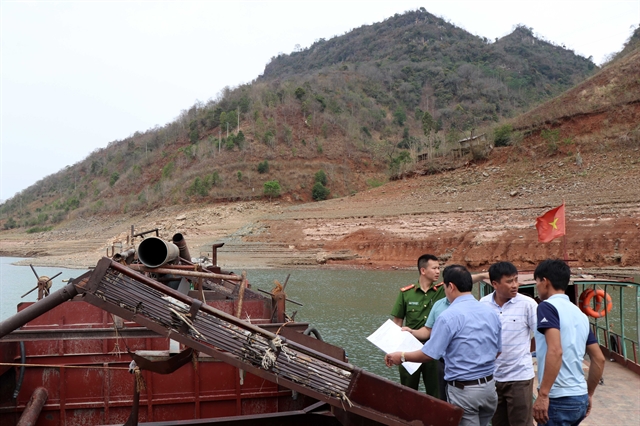 Society
Society


|
| Local authorities and police units of Mai Sơn District, Sơn La Province, inspected a sand-carrying vessel on the Đà River. — VNA/VNS Photo |
SƠN LA — Illegal sand mining on the Đà River in the northern mountainous province of Sơn La has become more and more serious in recent years.
Sơn La Province had been looking at solutions to effectively handle the situation as well as protect its sand resources.
In Tạ Bú Commune, Mường La District, there are many illegal 'sand gathering' sites where people sell illegally-mined sand.
The mining normally happens from February to May when the water level in the Hoà Bình hydro-power plant's reservoir on the Đà River drops.
Nguyễn Văn Bắc, vice chairman of the Mường La People’s Committee, told Vietnam News Agency that “the illegal sand mining on the Đà River was commonplace due to the lack of officials available to monitor it.”
“Moreover, determining the origin of the sand was very difficult because most traders had legal receipts that proved they bought the sand from other regions,” said Bắc.
To handle the situation, the district had asked competent forces to intensify inspections and monitor illegal sand mining, transporting and trade.
Since June last year, local authorities have uncovered 29 illegal sand mining and trading cases and confiscated more than 100cu.m of sand.
The violators were fined VNĐ100 million (US$4,000).
Further upstream in Mai Sơn District, there are a number of sand mines in Tà Hộc and Chiềng Chăn communes, which used to be a “hot spot” for illegal exploitation.
Transporting sand from Tà Hộc Port to Mai Sơn District has also caused serious damage to the provincial Highway 10.
Mai Sơn District authorities have taken several measures to handle the situation.
The provincial Department of Natural Resources and Environment has been instructed to conduct sand reserve surveys and set up mining plans as well as organise bidding for sand exploitation licences.
So far, two businesses have been granted licences to extract sand from the Đà River.
Their designated mining sites have been clearly marked to avoid illegal exploitation and ensure social security and order in Tà Hộc Commune.
“There has been no illegal sand mining in the commune since the two businesses were licensed to exploit sand on the Đà River,” said Lèo Văn Hoa, vice chairman of Tà Mộc Commune, adding that police has kept close watch over any suspect or strange ships coming into the area.

|
| A truck carrying illegally-mined sand seized by the police in Mường La District, Sơn La Province. VNA/VNS Photo Hữu Quyết |
A vehicle weighing station has been set up at Tà Hộc Port to oversee the loads of trucks transporting sand to reduce damage to the roads.
To enhance the State management of minerals, the district had set up special teams to inspect mining activities and ensure that laws on the environment, water resources, minerals and land are followed by organisations and households in the district, said Lò Văn Biên, an official from Mai Sơn District’s Department of Natural Resources and Environment.
However, handling the illegal sand mining still faced many difficulties.
One of the reasons is that illegal exploitation often takes place in remote mountainous areas, far from residential places.
Illegal miners also operate at random, so detecting and arresting them was difficult because authorised forces were not equipped to patrol the river frequently.
In addition, the awareness of people in remote areas about environmental and natural resource protection was still limited.
“We need to spread the word about protecting these resources,” said Đoàn Văn Học, head of Sơn La’s Water Resources, Minerals and Hydro-meteorology Centre.
“Heads of districts must take responsibility for illegal sand exploitation in their areas,” Học said.
Besides, investors of construction projects must make sure that the sand they are using is legal when the sand and gravel are proven to be from legal sources. — VNS